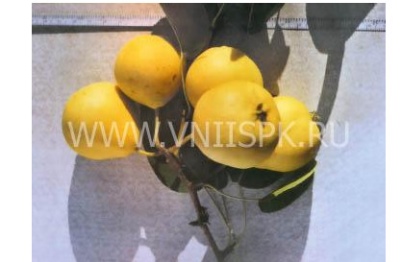
- Authors: E.A. Falkenberg, M.A. Mazunin, L. I. Bolotova (South Ural Research Institute of Horticulture and Potato Growing)
- Appeared when crossing: (41-15-9) x Severyanka
- Year of approval: 2001
- Fruit weight, g: 44
- Ripening terms: late autumn
- Fruit picking time: September 15-25
- Appointment: fresh
- Growth type: medium height
- Yield: high
- Height, m: up to 5
In regions with cool summers and risky farming, it is quite difficult to grow a fruit tree, since you need to select a variety adapted to the peculiarities of the climate. One of these is the late autumn pear variety Uralochka.
Breeding history
Pear Uralochka is a variety with a long history, which was bred in 1967 by domestic scientists of the South Ural Research Institute of Horticulture and Potato Growing (M. A. Mazunin, L. I. Bolotova and E. A. Falkenberg). Several varieties were used to create the species - Severyanka and 41-15-9. In 2001, the fruit crop was included in the State Register of Breeding Achievements of the Russian Federation. The pear is zoned in the Ural, West Siberian and East Siberian regions.
Description of the variety
Uralochka is a medium-sized tree, the height of which does not exceed 5 m. It is characterized by a rounded and spreading crown with moderate thickening of green foliage with a shiny surface. The skeleton of a tree consists of upright branches, sparsely spaced from each other. The fruits are tied on simple and complex ringlets. During the flowering period, the tree is covered with not very large pinkish flowers that emit a pleasant aroma.
Fruit characteristics
Uralochka is a small-fruited pear variety. The average fruit weight is 44 g. The shape of the fruit is correct - short pear-shaped with a smooth surface. In a state of removable maturity, the fruit is evenly covered with a greenish-yellow color. At the stage of consumer maturity, the pear acquires a golden yellow color. As soon as the fruits are ripe, it is recommended to remove them, because after 10-12 days the fruits begin to crumble together.
The peel of fruits is of medium density, dryish, without pronounced shine, rough to the touch. On the surface of the fruit, subcutaneous small points are pronounced. A feature of the fruit is good transportability and long shelf life - up to 1 month. The purpose is universal - fruits are eaten fresh, canned, pickled and processed.
Taste qualities
The fruit has good taste and marketability. The creamy pulp is characterized by a delicate, fine-grained and moderate consistency. Pears have a balanced taste, sweet and sour with a moderate aroma. In addition, the fruit has excellent juiciness.
Ripening and fruiting
The Uralochka pear tree belongs to the category of late autumn species. The culture begins to bear fruit in the 4th year after planting. Fruit ripening begins in the 2-3rd decade of September. The best period for harvesting fruits is September - from the 15th to the 25th. Fruiting in a pear tree is regular.

Yield
The productivity of the variety is high. Yields increase every year, reaching a maximum in the 7-8th year of growth.On average, a tree gives about 39 kg of ripe pears during the fruiting period. On an industrial scale, the yield indicators are as follows - 25 hectares of fruit per 1 centner.
Self-fertility and the need for pollinators
This pear species is self-fertile. To get a good harvest, you will need donor trees that bloom at the same time as the Uralochka pear. All varieties need to be planted in one area. The best pollinating trees are such species as Powislaya, Vekovaya and Larinskaya.
Landing
Planting a pear seedling is carried out in the spring, when the air and soil are warmed up, or in the fall - 1.5-2 months before stable cold weather. When planting seedlings, do not forget about observing the distance between the trees so that they do not shade each other, as well as the root systems have enough space for development.


Growing and care
The variety does not require special agricultural technology, but it is a little capricious to the soil. The best for the tree will be black soil and forest loams. It is necessary to plant seedlings on a hill, since the root system does not like moisture stagnation, that is, groundwater must flow deep. Pear agrotechnics consists of irrigation, fertilizing with mineral and organic components, loosening and weeding of the soil in the near-stem zone, sanitary, shaping and rejuvenating pruning of branches, as well as protection from insects and viruses.



Disease and pest resistance
The tree has strong immunity. It is not affected by scab and is also resistant to fire blight. In addition, the variety has a high resistance to gall mites. If any disease is found, it is recommended to immediately remove the damaged section of the tree so that the virus does not spread further.

Like any other fruit trees, the pear needs protection from various diseases and pests. When planting a pear on your site, you need to know in advance what diseases you should beware of. To successfully carry out the struggle, it is necessary first to correctly identify the cause of the problem. It is important to distinguish signs of disease from manifestations of the presence of insects, mites, caterpillars and other types of pests.
Resistance to soil and climatic conditions
The stress resistance of the fruit crop is high.The pear is endowed with record frost resistance, and is also able to tolerate short-term shade and drought. The advantage of the variety is its resistance to spring frosts. The variety does not like excessive moisture and dampness.





































































